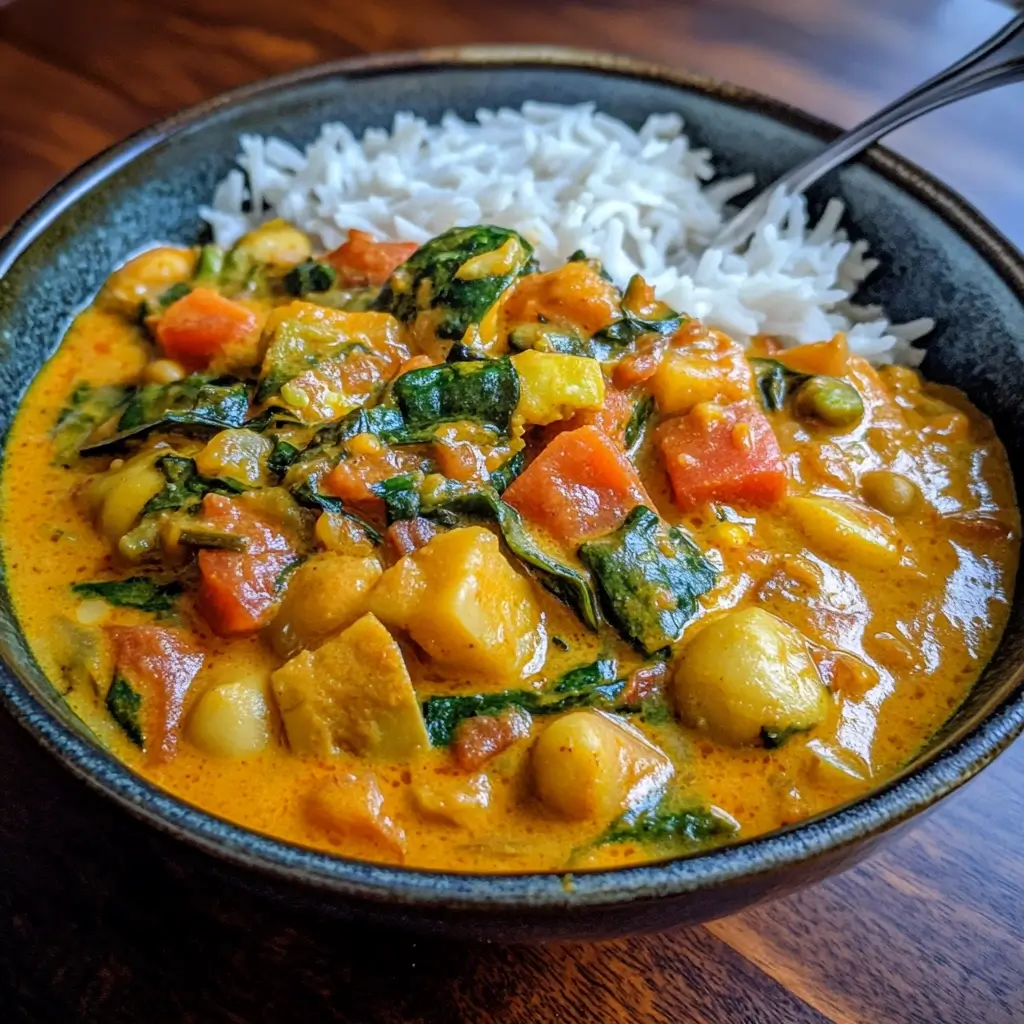There are some dishes that just instantly transport you to a place of comfort and warmth, and for my family, this Veggie Coconut Curry is exactly that. I first whipped it up on a chilly autumn evening, hoping to create something nourishing and satisfying that everyone, from my spice-averse youngest to my flavour-adventurous partner, would enjoy. The aroma alone, a fragrant blend of ginger, garlic, and warming spices melding with creamy coconut milk, had everyone drifting into the kitchen with eager anticipation. The verdict? An absolute triumph! It was devoured with such enthusiasm that it’s become a cherished regular in our meal rotation. It’s wonderfully versatile, allowing for a rainbow of vegetables, and the balance of creamy, savoury, and subtly sweet notes is simply divine. This isn’t just a recipe; it’s a bowlful of happiness, a hug in a dish, and I’m so excited to share it with you, hoping it brings as much joy to your table as it does to ours.
Ingredients
Here’s what you’ll need to create this vibrant and flavourful Veggie Coconut Curry. Each ingredient plays a crucial role in building layers of taste and texture.
- 1 tablespoon Coconut Oil (or vegetable oil): For sautéing the aromatics, providing a subtle coconut undertone.
- 1 large Onion, finely chopped: Forms the flavour base, adding sweetness and depth.
- 3 cloves Garlic, minced: An essential aromatic, bringing a pungent and savoury kick.
- 1-inch piece Ginger, freshly grated: Adds a warm, zesty, and slightly spicy note.
- 1 Red Bell Pepper, sliced: Lends sweetness, vibrant colour, and a pleasant crunch.
- 1 Green Bell Pepper, sliced: Offers a slightly more savoury pepper flavour and more colour.
- 2 medium Carrots, peeled and sliced into rounds or half-moons: Provide sweetness, earthiness, and a firm texture.
- 1 medium Sweet Potato (about 300g), peeled and diced into 1-inch cubes: Adds natural sweetness, creaminess, and substance.
- 1 head Broccoli, cut into florets: Brings a lovely green colour and slightly bitter, earthy notes that complement the curry.
- 2 tablespoons Red Curry Paste (adjust to your spice preference): The heart of the curry, providing a complex blend of chilli, lemongrass, galangal, and spices. Choose a good quality paste.
- 1 teaspoon Ground Cumin: Adds an earthy, warm flavour.
- 1 teaspoon Ground Coriander: Lends a mild, citrusy, and slightly sweet note.
- ½ teaspoon Turmeric Powder: For its vibrant colour and earthy, slightly bitter taste, plus its health benefits.
- 1 can (400ml / 13.5 oz) Full-Fat Coconut Milk: Creates the luscious, creamy sauce. Full-fat is recommended for the best texture and flavour.
- 1 cup (240ml) Vegetable Broth: Helps to thin the sauce to the perfect consistency and adds another layer of flavour.
- 1 can (400g / 15 oz) Chickpeas, rinsed and drained: Adds plant-based protein and a pleasant, slightly nutty texture.
- 2 cups (approx. 60g) Fresh Spinach, roughly chopped: Wilts into the curry, adding nutrients and a touch of green.
- 1 tablespoon Soy Sauce (or tamari for gluten-free): Enhances umami and savoury notes.
- 1 tablespoon Lime Juice, freshly squeezed: Brightens all the flavours at the end, adding a crucial acidic counterpoint.
- Salt and freshly ground Black Pepper to taste: To season and enhance all the other flavours.
- Optional for Garnish: Fresh Cilantro (coriander leaves), chopped; Lime Wedges; Red Chilli Flakes; Toasted Cashews or Peanuts.
Instructions
Follow these steps carefully to create a perfect Veggie Coconut Curry every time. The process involves building layers of flavour, so don’t rush the initial stages!
- Prepare the Aromatics: Heat the coconut oil in a large, heavy-bottomed pot or Dutch oven over medium heat. Once the oil is shimmering, add the chopped onion and sauté for 5-7 minutes, or until softened and translucent.
- Add Ginger and Garlic: Stir in the minced garlic and grated ginger. Cook for another 1-2 minutes until fragrant, being careful not to burn the garlic.
- Introduce the Spices and Hardy Vegetables: Add the red curry paste, ground cumin, ground coriander, and turmeric powder to the pot. Stir well and cook for 1-2 minutes, allowing the spices to toast and become deeply aromatic. This step is crucial for developing flavour.
- Sauté Vegetables: Add the sliced bell peppers, carrots, and diced sweet potato to the pot. Stir to coat them evenly with the spices and aromatics. Sauté for 5-7 minutes, allowing the vegetables to soften slightly and absorb some of the flavours.
- Create the Curry Sauce: Pour in the full-fat coconut milk and vegetable broth. Stir everything together thoroughly, scraping up any browned bits from the bottom of the pot (these are packed with flavour!). Bring the mixture to a gentle simmer.
- Simmer and Soften: Once simmering, reduce the heat to low, cover the pot, and let the curry cook for 15-20 minutes, or until the sweet potatoes and carrots are tender when pierced with a fork. Stir occasionally to prevent sticking.
- Add Remaining Vegetables and Chickpeas: Stir in the broccoli florets and the rinsed and drained chickpeas. Cook for another 5-7 minutes, or until the broccoli is tender-crisp and bright green. You want it cooked through but still with a slight bite.
- Wilt in the Spinach: Add the fresh spinach to the pot. Stir gently until the spinach wilts down into the curry, which should only take a minute or two.
- Final Seasoning and Flavour Boost: Remove the curry from the heat. Stir in the soy sauce (or tamari) and fresh lime juice. Taste the curry and adjust seasoning as needed – you might want to add more salt, pepper, a touch more curry paste for heat, or a little more lime juice for brightness.
- Rest and Serve: Let the curry rest for 5-10 minutes before serving. This allows the flavours to meld together even more beautifully. Serve hot over your favourite rice or with naan bread, and garnish as desired.
Nutrition Facts
This Veggie Coconut Curry is not only delicious but also packed with beneficial nutrients.
- Servings: This recipe generously serves 4-6 people.
- Calories per serving (approximate for 6 servings): Around 380-450 kcal per serving (this can vary based on exact vegetable quantities and specific brands of ingredients used).
- Fiber: Rich in dietary fiber from the abundance of vegetables and chickpeas, promoting digestive health and satiety. A single serving can provide a significant portion of your daily fiber needs.
- Healthy Fats: Contains healthy fats primarily from coconut milk, which includes medium-chain triglycerides (MCTs) that are metabolized differently by the body.
- Vitamins & Minerals: A good source of Vitamin A (from carrots and sweet potatoes), Vitamin C (from bell peppers and broccoli), and Iron (from spinach and chickpeas), supporting immune function, vision, and energy levels.
- Plant-Based Protein: The chickpeas provide a good source of plant-based protein, making this a satisfying and complete meal, especially for vegetarians and vegans.
- Antioxidants: Loaded with antioxidants from the colourful vegetables, spices like turmeric, and fresh ginger, which help combat oxidative stress in the body.
Preparation Time
Understanding the time commitment can help you plan your cooking session.
- Prep Time (Chopping & Measuring): Approximately 20-25 minutes. This involves washing, peeling, and chopping all the vegetables and measuring out the spices and liquids. Efficient mise en place is key!
- Cook Time: Approximately 35-45 minutes. This includes sautéing the aromatics, simmering the vegetables until tender, and allowing the flavours to meld.
- Total Time: Approximately 55-70 minutes from start to finish. This makes it a manageable meal for a weeknight if you’re efficient with your prep, or a relaxed weekend cooking project.
How to Serve
Serving this Veggie Coconut Curry with the right accompaniments and garnishes can elevate the entire experience. Here are some suggestions:
- Base Grains:
- Steamed Basmati Rice: The classic choice. Its fragrant, fluffy grains are perfect for soaking up the creamy curry sauce.
- Jasmine Rice: Another excellent aromatic rice option, slightly stickier than basmati.
- Brown Rice: A healthier, whole-grain alternative with a nuttier flavour and chewier texture.
- Quinoa: A protein-packed, gluten-free option that pairs wonderfully with the curry.
- Cauliflower Rice: For a low-carb, keto-friendly alternative.
- Breads:
- Naan Bread (Garlic or Plain): Perfect for scooping up every last bit of the delicious sauce. Warm it slightly before serving.
- Roti or Chapati: Whole wheat flatbreads that are also great for dipping.
- Fresh Garnishes (Choose a few or all!):
- Fresh Cilantro (Coriander Leaves): A generous sprinkle of roughly chopped cilantro adds a burst of freshness and a classic curry flavour.
- Lime Wedges: Essential for squeezing over the curry just before eating. The acidity brightens all the flavours.
- Sliced Green Onions (Scallions): Add a mild, fresh oniony bite and visual appeal.
- Fresh Thai Basil Leaves: If you can find them, they add an authentic, slightly anise-like flavour.
- Crunchy Toppings:
- Toasted Cashews or Peanuts: Roughly chopped and sprinkled on top for a delightful crunch and nutty flavour. Toast them lightly in a dry pan for a few minutes until fragrant.
- Toasted Coconut Flakes: Enhances the coconut flavour and adds a delicate crispness.
- Crispy Fried Onions: For an extra layer of savoury crunch.
- Spice & Creaminess Boosters:
- Red Chilli Flakes or Sliced Fresh Chillies (e.g., Bird’s Eye): For those who like an extra kick of heat.
- A dollop of Coconut Yogurt or Plain Yogurt (dairy or non-dairy): Adds extra creaminess and a cooling counterpoint, especially if your curry is spicy.
- Presentation:
- Serve the curry in individual bowls over a bed of rice.
- Arrange garnishes in small bowls on the table so everyone can customize their own serving.
- A beautiful serving spoon makes dishing it out even more enjoyable.
Additional Tips
To make your Veggie Coconut Curry experience even better, consider these handy tips:
- Customize Your Veggies: This recipe is incredibly versatile. Feel free to swap or add vegetables based on seasonality or preference. Zucchini, mushrooms, cauliflower, peas, green beans, butternut squash, or even kale would work wonderfully. Adjust cooking times accordingly for softer or harder vegetables.
- Control the Spice Level: Red curry paste varies in heat. Start with the recommended amount, taste, and add more if you prefer a spicier curry. You can also add a pinch of cayenne pepper or a deseeded, finely chopped fresh chilli along with the garlic and ginger for extra controlled heat. For a milder version, use less curry paste or look for a mild variety.
- Boost the Protein: While chickpeas add good protein, you can further enhance it by adding cubed firm or extra-firm tofu (pan-fry or bake it separately until golden and add it towards the end), edamame, or even red lentils (add them with the broth; they’ll cook down and thicken the curry).
- Make it Ahead: Curry often tastes even better the next day as the flavours meld. You can prepare the entire dish, let it cool, and store it in an airtight container in the refrigerator for up to 3-4 days. Reheat gently on the stovetop or in the microwave.
- Freezing Instructions: This curry freezes well. Allow it to cool completely, then transfer it to freezer-safe containers, leaving some headspace. It can be frozen for up to 2-3 months. Thaw overnight in the refrigerator and reheat gently. The texture of some vegetables might change slightly upon thawing, but it will still be delicious.
- Adjust Consistency: If you prefer a thicker curry, you can simmer it uncovered for a little longer to allow some liquid to evaporate. Alternatively, mix a tablespoon of cornstarch with two tablespoons of cold water to make a slurry and stir it into the simmering curry until thickened. For a thinner curry, simply add a bit more vegetable broth or water.
- Toast Whole Spices (Optional Pro Tip): If you have whole cumin and coriander seeds, lightly toast them in a dry pan until fragrant before grinding them. This intensifies their flavour significantly compared to pre-ground spices.
- Don’t Skip the Fresh Lime Juice: The acidity from fresh lime juice added at the end is crucial. It cuts through the richness of the coconut milk and brightens all the individual flavours, making the curry taste more vibrant and balanced. Bottled lime juice doesn’t have the same fresh impact.
FAQ Section
Here are answers to some frequently asked questions about making Veggie Coconut Curry:
- Q: Can I make this Veggie Coconut Curry vegan?
A: Yes, absolutely! This recipe as written is naturally vegan, provided you use vegetable oil or coconut oil (not ghee) and ensure your red curry paste is vegan (most are, but always check the label for shrimp paste or fish sauce). Use tamari instead of soy sauce if you need it to be strictly gluten-free and vegan (some soy sauces can have non-vegan additives, though rare). - Q: Can I use light coconut milk instead of full-fat?
A: You can, but the curry will be less creamy and rich. Full-fat coconut milk provides the best flavour and texture. If you use light coconut milk, the sauce will be thinner. You might want to compensate by adding a cornstarch slurry (as mentioned in tips) or simmering it longer to thicken. - Q: What are the best vegetables to use if I want to vary from the recipe?
A: The beauty of this curry is its adaptability! Great options include:- Harder Veggies (add earlier): Butternut squash, potatoes, parsnips.
- Medium Veggies (add mid-way): Zucchini, yellow squash, mushrooms (cremini, shiitake), cauliflower florets, green beans.
- Softer Veggies (add towards the end): Peas (fresh or frozen), edamame (shelled), asparagus, kale.
Consider colour, texture, and flavour combinations you enjoy.
- Q: How long does this curry keep in the refrigerator?
A: Stored in an airtight container, leftover Veggie Coconut Curry will keep well in the refrigerator for 3-4 days. In fact, many find the flavours deepen and improve by the second day. - Q: I don’t have red curry paste. Can I use something else?
A: Red curry paste is quite unique. If you don’t have it, you could try green curry paste (it will have a different, often spicier and more herbaceous flavour profile) or yellow curry paste (generally milder and more turmeric-forward). In a pinch, you could try a good quality curry powder (like Madras curry powder) and increase the amounts of cumin, coriander, and turmeric, possibly adding a pinch of cayenne for heat and a touch of tomato paste for depth, but the flavour will be different from a paste-based curry. - Q: Is this recipe gluten-free?
A: Yes, this recipe can easily be gluten-free. Ensure your vegetable broth is gluten-free and use tamari instead of soy sauce (as some soy sauces contain wheat). Most red curry pastes are gluten-free, but it’s always wise to check the label. - Q: How can I make this curry creamier without adding more coconut milk?
A: A few options:- Cashew Cream: Soak raw cashews in hot water for 30 minutes, then blend with a little fresh water until smooth. Stir this into the curry at the end.
- Potato Starch/Cornstarch Slurry: Mix 1 tablespoon of cornstarch or potato starch with 2 tablespoons of cold water, then stir into the simmering curry until it thickens.
- Blend a Portion: Carefully remove about a cup of the curry (mostly sauce and softer veggies like sweet potato) and blend it until smooth, then stir it back into the pot.
- Q: My curry isn’t flavourful enough. What went wrong?
A: Several factors could contribute:- Under-seasoning: Don’t be shy with salt! It enhances all other flavours. Also, ensure you’ve added enough curry paste for your liking.
- Old Spices: Ground spices lose their potency over time. Use fresh, good-quality spices.
- Not Toasting Spices: Sautéing the curry paste and dry spices in oil for a minute or two (blooming) is crucial for releasing their aromas.
- Missing Acidity/Umami: The fresh lime juice and soy sauce (or tamari) added at the end are vital for balancing and boosting flavours. Don’t skip them!
- Quality of Coconut Milk: A good quality, full-fat coconut milk makes a big difference.






